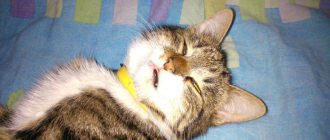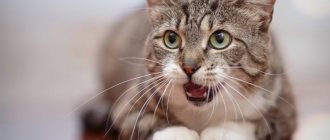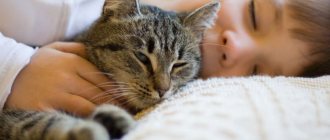Sometimes, quite by accident, when you take your beloved pet in your arms, you realize that something is wrong. On your favorite fluffy face you can see frightening bald patches. And a whirlwind of questions immediately arises in my head. Where did this come from? What to do? What is this? Is this treatable? In fact, you can calm yourself down. This pathology is quite common among cats and can be treated quite successfully. You can find out more about this in this article.
Having discovered bald spots, it is important to take timely action!
The cat has sores on its head and hair has come out: Causes
Many factors can contribute to hair loss and the appearance of wounds on a cat’s head, neck, withers and other parts of the body:
- Flea infestations and other parasites can cause itching, self-induced alopecia, and dermatitis.
- Allergy. It can be different: to components of the diet, to something from the environment.
- Contact dermatitis. It often occurs at the site where flea drops are used or when medications are administered subcutaneously. Crusting is often reported with Baytril injection in cats.
- Other inflammatory and non-inflammatory processes in the dermis.
Skin diseases
The presence of diseases can also affect the condition of the cat's fur and its loss. Let's list the ones that often occur and cause severe loss.
- Skin mites . A skin lesion that is very unpleasant for an animal, causing discomfort with severe itching, rashes, and inflammatory phenomena that appear in areas of the skin affected by mites. You can recognize the disease by the first symptoms, which appear in the form of dull fur and bald spots on the face, ears and front legs.
- Fungal diseases (ringworm, mycosis). Having discovered the first signs of such lesions, you cannot take any measures on your own; immediately contact a veterinary clinic. We must remember that they are very dangerous for people. A sign of a fungal disease is that the hair falls out in round bald spots, which then form entire lesions. Inside them, scaly formations on the skin are noticeable. After diagnosis, the veterinarian will prescribe treatment, which must be strictly followed.
- Flea dermatitis . Flea saliva can cause an allergic reaction in cats. In addition to extensive hair loss, it can lead to severe redness and itching of the skin. With this disease, most often cats may lose hair on their back.
- Allergic dermatitis . Cats can react to irritants such as household chemicals, pollen, dust, etc. All these substances can cause quite severe allergies, which, in addition to hair loss, causes discomfort to the pet in the form of itching, redness of the skin, and the cat develops sores in areas where it is scratched.
- Psychological reaction to external factors . The sensitivity of cats to external stimuli is not new. Any phenomenon that causes stress in an animal can make the cat not only timid and even aggressive, but also encourage him to pull out his fur with his teeth in those areas where he can reach. This includes the stomach, the back, and the paws. At the same time, bleeding wounds and ulcers appear on bald skin, which can become a gateway for various infections.
- Seborrhea . This skin disease is characterized by particularly severe hair loss on any part of the body. The skin becomes inflamed, oily, and foul-smelling.
© shutterstock
Only a competent veterinarian can determine the exact reason why a cat’s hair is falling out, because the same symptoms can be a manifestation of various diseases. To make a diagnosis, you will need to undergo a series of examinations and tests. Based on the diagnosis, the doctor will prescribe treatment that will help restore the pet’s skin and coat.
The cat has a sore on the neck and hair is falling out: Diagnosis
There are several methods to determine the cause of a cat’s illness:
- Flea feces detection test.
- Studying the cellular composition of the skin using fingerprint smears, scrapings, and tape.
- Scrapings to identify ectoparasite mites .
- Cultures to identify bacteria and fungi.
- Histological examination of the skin.
- Other studies are used less frequently; the decision to prescribe them is made by the doctor. Remember that you have the right to ask the doctor to give you an explanation of why this or that procedure is needed.
Watch the video: Veterinarian advice - Skin diseases in cats and their diagnosis
How to deal with shedding in apartment cats?
Seasonal molting is common to all animals, and even insects. If your cat sheds hair twice a year, this is normal. But a pet that is constantly within the apartment loses its biorhythms, which are responsible for regulating shedding. This can be affected by central heating, stress accompanied by metabolic disorders, lack of physical activity, and poor nutrition. Therefore, a cat can shed constantly throughout the year. This process may intensify in the off-season.
Gorgeous coat - healthy cat
Prevention of hair loss in cats includes:
- Proper nutrition with high-quality food, taking into account the breed, age and other characteristics of the cat.
- Vitamins for cats against hair loss, which should be given to the animal before autumn and spring molting.
- Regular combing with special combs and brushes. Many cat lovers consider the Furminator to be the most effective hair care product. He combs out not only fallen hairs, but also hairs that will soon fall out. The procedure takes place with comfort for the pet.
To keep your mustachioed pet's fur smooth and silky and minimize hair loss, follow the tips above.
Determining the causes of hair loss in cats, treatment:
The cat itches until it hurts and the hair falls out: How to treat it at home?
Every owner should understand that many drugs that can be used by humans and other animals cannot be used on cats.
For example, skin lesions are often treated with Yam BK ointment. This is strictly forbidden, since the tar contained in this drug is toxic to cats.
Like this article? Read other materials about cats on our website: How to give medicine to a cat? Tips for ensuring comfort for a cat - How to learn to understand your cat (Practical tips) -
How can you help yourself without causing harm?
Try to limit access to the body area if the cat injures itself. A protective collar or blanket can help with this.
Trim your cat's claws or apply safe anti-scratch pads.
Itching can be controlled using a suspension or spray with the same name Stop Itching . It is important to understand that you will only remove the symptom, and after a course of the drug the problem may return.
The crusts can be soaked and removed using saline or Chlorhexedine.
Also, if there has been no treatment for fleas and ticks for a long time (the apple tree is a month old), it is worth doing it. Suitable drugs: Stronghold, Lawyer, Helmintal, Inspector, Bravecto.
And, of course, we recommend taking your pet to see a doctor as soon as possible.
Prevention
Problems when a cat has bald ears, belly, peeling heels, back or tail at the base arise quite often, but they are quickly treated. But in order not to injure the animal, violations should be prevented. To prevent the appearance of alopecia, veterinarians recommend monitoring the hygiene and nutrition of the animal. The cat must be kept in clean conditions so that it does not get infected. In order to identify violations in time, it is advised to regularly consult a doctor and independently check the condition of your pet’s skin. This will allow you to find out at the first stages of the development of the pathology why the fur is coming out and remove the disease. If hair falls out on the ears or the back becomes bald, you cannot treat it yourself, so as not to worsen the condition of your pet.
List of drugs for the treatment of dermatitis in cats
After determining the factor that caused the damage to the skin and coat, the veterinarian may prescribe one of the drugs or a combination:
- Cortavance , Exekan to relieve itching and inflammation.
- Sinulox to eliminate bacterial infection.
- Terbinafine or Lyme sulfur against fungi.
- Shampoo for itching or inflammation. For example, Green Doctor, Globalvet with chlorhexedine.
- Drops on the withers against parasites: Broadline, Inspector, Bravecto.
- Ointments, creams or emulsions, for example Fucidin.
- Vitamins and other nutrients for speedy skin restoration, for example Laveta super or Supercoat.
- Veterinary diet from Royal Canin, Hills, Proplan, Monge or Farmina aimed at improving the quality of coat and dermis.
Watch the video: Veterinarian talks about sores on a cat’s neck
How to carry out treatment?
If your cat's fur is falling out in clumps, ask your veterinarian what to do.
To make a diagnosis, laboratory and instrumental studies are used:
- blood analysis;
- skin scraping;
- use of Wood's lamp;
- hair examination;
- Ultrasound;
- X-ray.
Depending on the identified cause, the mustachioed patient is prescribed surgical or drug therapy. In case of hormonal imbalances, castration is performed, and if oncology is detected, the tumor is excised.
Among the drugs used:
- sedatives that reduce stress levels;
- antibacterial and antifungal, fighting bacterial and fungal infections;
- antihistamines, which suppress the production of histamine during allergies;
- antiparasitic, destroying fleas, ticks and helminths;
- immunostimulants that stimulate the work of immune cells.
In addition to taking medications, antiseborrheic shampoos, ointments and antiseptics are prescribed to treat suppurations. If a food allergy is suspected, the animal is placed on a strict diet.
A cat has sores on its neck and hair is falling out: Where to go?
Saint Petersburg:
- Sotnikov Veterinary Clinic. One of the best clinics in Russia. They deal with both complex cases that require a consultation of doctors, as well as simpler ones. The clinic's doctors are lecturers at conferences aimed at improving the skills of other doctors.
- Vetnet. Specialists will make an accurate diagnosis quickly. Quality treatment will be prescribed.
- Vetus. Top-class veterinary dermatologists work here.
Moscow:
- Medea . A wide range of veterinary services from nail trimming to ultrasound. There is a hospital. Doctors make decisions quickly and efficiently, prescribe only the necessary diagnostics and treatment without frills.
- Clinic Gav. 20% discount on consultations without animals. Friendly staff. Convenient location.
- Your doctor. Renowned dermatologists provide appointments by appointment. It is possible to immediately carry out all diagnostic procedures if the pet is properly prepared. You can always find out more information by phone or on the clinic’s website.
Rostov-on-Don:
- Center. One of the best clinics in Rostov-on-Don. Visitors note the abundance of pet products in the pharmacy. They speak positively about the staff, both administrators and doctors.
- Animal friend. High-class specialists will provide quick and high-quality assistance to your pet if you contact them in a timely manner. There is a flexible system of discounts. Friendly administrators will help and explain everything.
- Veterinary clinic of Dr. Zarubin. The initial appointment is only 200 rubles. Other manipulations are performed according to the price list. The experience of doctors allows us to quickly make an accurate diagnosis and prescribe treatment.
Quantity
Endoparasites
If you notice your pet constantly wanting to scratch a bare area, this may indicate the presence of endoparasites. For example, scratching with teeth or claws may occur in an animal due to unpleasant flea bites. In order to relieve the animal from unpleasant sensations, special solutions, sprays and drops for the withers are used. Treatment must be carried out several times in order to remove not only adult individuals from the fur, but also newly hatched larvae.
Of all the internal organs, the intestines are the most susceptible to parasite penetration. Antihelmintic drugs are excellent for removing worms from the body. However, if the case is advanced (for example, when infected with large worms), the cat may need surgical intervention.
You might be interested in: What causes anemia in cats: symptoms, treatment, prevention.
Ear mites can be treated with drops and proper care for your pet. You will need to remove him from contact with stray animals and prohibit him from eating rodents and wild birds.











